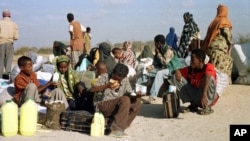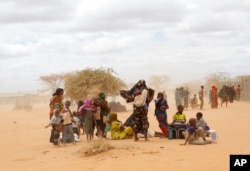The Kenyan government is delaying its decision to close the huge Dadaab refugee camp, which houses nearly 300,000 people, most of them Somalis. But Kenya's interior minister insists the process to repatriate the Somalis will continue.
Kenyan Interior minister Joseph Nkaisserry said his country had postponed the closure of Dadaab camp, currently home to more than 280,000 Somali refugees.
Nkaisserry told reporters in Nairobi Wednesday the Kenyan government was responding to a request by the United Nation refugee agency UNHCR and Somali government not to close the camp.
“I wish to announce the government has accepted the request to extend the deadline for the completion of the repatriation of Somali refugees and eventual closure of Dadaab refugee complex by six months. However, the ongoing voluntary repatriation will continue uninterrupted,” he said.
The minister was joined by UNHCR officials and Somali government representatives.
In May, Kenya's government announced it would shut down Dadaab by November 30. The camp was opened in 1991 when Somalia descended into civil war after the fall of the Mohamed Siad Barre regime. At one point, the sprawling camp held some 400,000 refugees.
Kenyan security agencies repeatedly said the camp was a security threat, citing activity in the camp by the Somali militant group al-Shabab.
In recent months, tens of thousands of Somali refugee have returned home. However, most of the returnees say basic needs, such as getting basic needs like food, shelter, clean water and schools, are not being met.
Nkaisserry said the political and security situation in Somalia has led Kenya to reconsider their earlier decision.
“The request for the extension was due to the delicate situation in Somalia. The Somali government is undergoing election period and quite a number of areas that has not been secured,” he said.
Al-Shabab still controls many parts of south and central Somalia and continues to fight forces of the government and the African Union force AMISOM, of which Kenya is a part.
Somali ambassador to Kenya Jamal Mohamed Hassan said his country lacks the capacity to take back its citizens.
“On the Somali side, we would like to tell the world we are willing and ready to receive our people. All we are trying to do and make sure is that the reception capacity on the other side is increased and we prepare the ground for them to come back,” he said.
When the new deadline to close Dadaab comes in May of next year, Nkaisserry said Somalis who have not returned home will be sent to other refugee camps.
“The closure of Dadaab camp does not mean Kenya is not taking refugees anymore. We still have Kakuma. [The] United Nations High Commission for Refugees has other refugee camps spread all over the world. That will be a program which will be considered,” he said.
Amnesty International released a statement that it welcomes the announcement to suspend the closure of the camp but calls on the Kenyan government to end what it called the forceful repatriation.
In the coming weeks, Kenya will host a special summit of the regional bloc IGAD to discuss the Somali refugee crisis and regional security.









